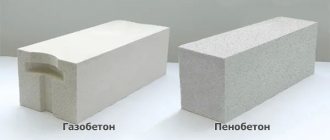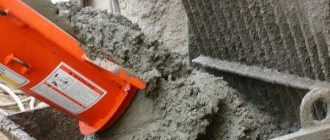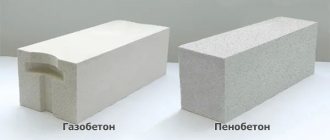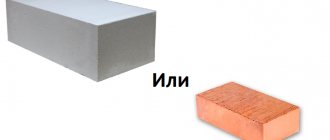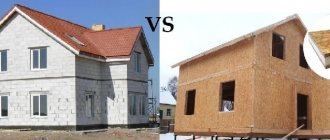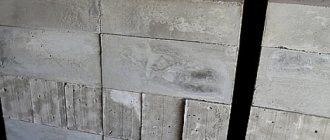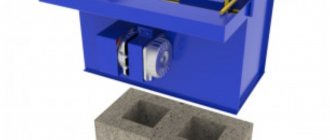Here is the third installment in a series of expert articles about comparing popular building materials. Today we will talk in detail about sand concrete blocks and find out their advantages and disadvantages over aerated concrete blocks.
- What is included in sand blocks?
- Are sand cement blocks really heavy and more suitable for foundation construction?
- Which material is more expensive and what is more profitable to build a house from?
Details in our article!
Part 1. Comparison of brick and aerated concrete | Part 2. Comparison of gas blocks and cinder blocks |
Dimensions
The standard sizes of sand blocks are identical to the sizes of cinder blocks - 390x190x188 mm. The most common type of gas blocks has a size of 600x300x200 mm. It’s not difficult to guess that building a house from aerated concrete will be much faster and easier.
| You can find more detailed information about the sizes of aerated concrete blocks, their volume and weight in our article - “How many aerated concrete blocks are in 1 cube of 600×300×200 mm?”
How much does Sandblock cost in Almaty?
Sand block price
| Name | Price |
| Sand block and hat (Brick / concrete / foam blocks) | 140 tenge. |
| Cinder block. Sand block . 20×40 (Brick / concrete / foam blocks) | 150 tenge. |
| Sand block (Brick / concrete / foam blocks) | 220 tenge. |
Used Soviet-made sand block | 120 tenge. |
Density and weight
The density of aerated concrete can vary from 300 kg/m3 (thermal insulation blocks) to 1200 kg/m3 (structural blocks). For sand blocks this value is almost 2 times higher - 1300-2200 kg/m3. One hollow sand concrete block, which can be used for building construction, weighs about 23 kilograms. The weight of one D500 gas block is 18 kilograms. And this takes into account the fact that an aerated concrete block is almost 3 times larger than a sand block!
All this suggests that sand-cement blocks are very heavy and a reinforced foundation will be required to build a house. For aerated concrete, reinforcement is not required. However, it must be admitted that solid sand blocks are perfect for building a foundation.
Composition of sand blocks
What a sand block is was discussed earlier. Sand block is a universal building material for walls and partitions in the house, the main materials for which are sand and cement.
In the manufacture of sand blocks, cement acts as a binder. Some craftsmen replace it with clay, gypsum or lime. However, it is still not worth giving up adding cement completely.
Sand is used as a filler in sand blocks. It is important that it is free of impurities in the form of earth or coal. An alternative to sand is slag or granulation.
The composition of sand blocks and its proportions are as follows:
- One part cement;
- Nine parts sand or slag;
- Water.
The calculation of materials for the manufacture of sand blocks is approximately as follows. From one bag of M500 cement, approximately 30 sand blocks are obtained. Moreover, to make one sand block, you will need approximately 15 kg of filler.
If we talk about large-scale production, then with 1000 kg of cement and 10,000 kg of sand, you will get approximately 600 sand blocks. This amount of material is enough to build a garage, the process of which has already been discussed on the website.
Sand block sizes
The weight of sand blocks, depending on their size, varies between 8-40 kg. In this case, the sizes of sand blocks can be different:
- Length 190-500 mm;
- Height 185-300 mm;
- Width 90-500 mm.
These dimensions are typical for wall sand blocks.
As for the fundamental blocks that are used when laying the base, their dimensions are much larger:
- Width 300-600 mm;
- Length 880-2380 mm;
- Height 280-580 mm.
To make sand blocks at home, you will first need to assemble molds that are installed on a vibrating table or other homemade device. To assemble forms for sand blocks, it is best to use wood, and the forms themselves should not have a bottom so that they can be easily disassembled into parts.
In addition, a distinctive feature of sand blocks is the presence of 2-3 voids inside. To organize them, you can use a bottle with which the finished mixture is pressed, or you can weld metal molds with two or three pieces of thick pipes inside.
Compressive strength
The average compressive strength of aerated blocks is 25-50 kg/cm2. Sand blocks definitely win here: their value ranges from 100 to 150 kg/cm2.
It can be assumed that sand-cement blocks are ideal for the construction of multi-story buildings because they are very durable. However, in practice, only a few houses are built from sand blocks higher than 3 floors. The main reason for this is too high thermal conductivity (read about the thermal conductivity of sand blocks below).
See what load the gas block can withstand on the press!
Advantages
A distinctive feature of the blocks is their increased level of sound insulation. They protect people in the building from the negative effects of external factors. The products meet the requirements for construction raw materials and are combined with other materials, including insulation materials. They are durable, reliable, tough. Let's take a closer look at the positive aspects:
- application for external and internal construction activities;
- increased strength, allowing for the construction of foundations;
- high coefficient of sound insulation provided by cavities;
- low weight of hollow blocks;
- long service life. The material is not subject to rotting, retains performance characteristics at high humidity, and is not susceptible to temperature changes;
- high resistance to elevated temperatures;
- environmental friendliness, which is based on the use of safe raw materials;
- low price is a plus that customers appreciate;
- savings during construction due to the fact that the dimensions allow using one sand block instead of three bricks. The result is the use of less mortar and bricks. The construction of buildings from sand blocks reduces costs by 40% compared to brickwork;
- reduction of construction time;
- simplicity of masonry, allowing you to build a building yourself without hiring hired builders.
Having these advantages, this material has a number of minor disadvantages.
Thermal conductivity
The thermal conductivity index of sand blocks is very high - 0.56-1.15 W/m•C° (higher than that of brick and cinder blocks). This is the main disadvantage of this building material. The thermal conductivity of aerated concrete blocks is only 0.15-0.3 W/m•C°. Consequently, the thickness of the wall of a house made of sand concrete blocks should be much greater. And, most likely, to create a comfortable microclimate in the house, a large amount of insulation will be required, and this is an additional cost.
Pros and cons of sand blocks
Let's look at the main advantages and disadvantages of using sand blocks. The advantages of this material are its high strength and resistance to external factors.
The materials from which sand blocks are made do not contain toxic substances, so they are absolutely harmless to use. The voids inside sand blocks can significantly reduce their weight and at the same time increase their sound and heat insulation characteristics.
A distinctive feature of sand blocks is that they practically do not absorb moisture. Well, the biggest advantage is the ease of manufacture and low cost of materials for these purposes.
Sand blocks have very few disadvantages, the main ones being low permeability and the need to insulate the structure. As you can see, blocks made of sand and cement have a large number of advantages and are practically devoid of disadvantages.
Solution consumption and “cold bridges”
Due to large differences in geometry and surface features, sand concrete blocks are laid exclusively on cement-sand mortar. The thickness of the seam is at least 12 mm, which indicates the presence of temperature bridges.
Aerated blocks can (and even should!) be placed on special glue. The consumption of glue is much less than the consumption of cement-sand mortar. And the thickness of the seam will be only 2-3 millimeters.
Composition and manufacturing process
Sand concrete is a type of structural concrete with a dense structure based on a cement binder and dense fine aggregate.
The composition of the sand concrete mixture ready for production should include only Portland cement, quartz sand and water. Molding takes place in steel molds on a special machine - a vibrating press, where the tamped mixture is regularly shaken to obtain uniformity throughout the entire volume. The blocks are then dried using heat or infrared. The molded products will gain tempering strength for another 28 days under natural conditions, i.e. in a warehouse at room temperature and sufficient ventilation.
Price
The average price of 1 cubic meter of sand blocks is 2700-3000 rubles. Aerated blocks cost a little more - 3000-3500 rubles per cubic meter. Despite the lower cost of sand concrete blocks, you need to pay attention to the following:
- To build a house from sand blocks, you will need a reinforced foundation.
- You need more sand-cement blocks than gas blocks.
- A house made of sand blocks must be insulated in any case, regardless of the region. Insulating a house made of aerated concrete is only necessary in areas with very low temperatures.
All these are additional costs that increase the final price of building a residential building. However, sand blocks are excellent for building fences, fences and outbuildings.
Other factors
In addition to the two main criteria for choosing a high-quality sand block, there are several other nuances. For example, you should also pay attention to the holes in the sand block, the walls between which should be dense and free of holes.
The building material itself must be neatly shaped and free from other defects (depressions, bulges, etc.). The ability to choose a high-quality sand block will give you a reliable guarantee that the construction using it will be durable.
Conclusion: when choosing a sand block, you should not rush and quickly give money to the manufacturer. It is best to first check the quality of the building material provided to you, and then pay for it.
Sand block fencing
Gas block
Dimensions
❌ ✅Density and weight
❌ ✅Compressive strength
✅ ❌Frost resistance
❌ ✅Thermal conductivity
❌ ✅Environmental friendliness and fire resistance
✅ ✅Solution consumption and “cold bridges”
❌ ✅Price
✅ ❌The table shows that gas blocks are superior to sand blocks in most respects. Businessmen who plan to engage in the production of building materials should be aware of another disadvantage of sand concrete blocks. There may be problems with the sale of sand blocks because people are not familiar with this material. But almost all of us have heard of aerated concrete.
How are cement-sand blocks produced?
Basic components for making sand blocks:
- cement;
- sand;
- water.
This composition of ingredients allows material manufacturers to not only save financial resources due to the low cost of raw materials, but also provide improved performance characteristics. The popularity of sand blocks has increased among customers, as it is a competitive raw material used in the construction of structures.
Manufacturing involves the technology of semi-dry vibrocompression on equipment with increased productivity. The production stages are as follows:
- Mixing raw materials components.
- Filling into steel molds.
- Compacting the fraction until homogeneous.
- Drying products under infrared rays.
- Keep in a ventilated room at room temperature for 4 weeks.
The main parameter is strength - the blocks are acquired after the final stage. Thanks to this, the service life of buildings constructed from them is more than half a century. This reduces the cost of repairing the facility over a long period after construction. The technology allows the use of a special filler during production, which reduces the impact of the weight of the object under construction on the foundation.
[testimonial_view id=”21"]


